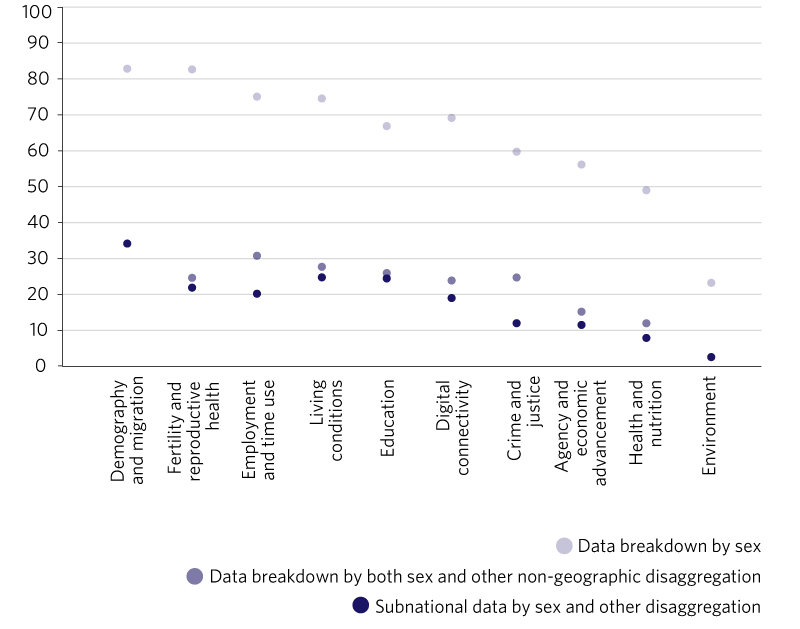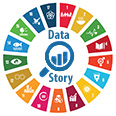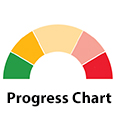Unlocking the power of data for sustainable development
Accurate, timely and disaggregated data are vital for measuring progress towards the 17 Sustainable Development Goals (SDGs) and 169 associated targets. Data help identify challenges, formulate solutions, monitor implementation and make needed course corrections. Without high-quality data providing an evidence base, it will be impossible to truly understand where we are succeeding and falling short on the SDGs. The Sustainable Development Goals Report 2024 provides a comprehensive overview of the world's progress nine years into the journey to 2030. Using the latest available data, the report highlights both successes and challenges as the international community strives to fully realize the ambitions and principles of the 2030 Agenda for Sustainable Development.
I. The current status of the SDGs: severely off track
The progress assessment carried out in 2024 reveals that the world is severely off track to realize the 2030 Agenda. Of the 169 targets, 135 can be assessed using available global trend data from the 2015 baseline to the most recent year, along with custodian agency analyses; 34 targets lack sufficient trend data or additional analysis. Among the assessable targets, only 17 per cent display progress sufficient for achievement by 2030. Nearly half (48 per cent) exhibit moderate to severe deviations from the desired trajectory, with 30 per cent showing marginal progress and 18 per cent moderate progress. Alarmingly, 18 per cent indicate stagnation and 17 per cent regression below the 2015 baseline levels.1 This comprehensive assessment underscores the urgent need for intensified efforts to put the SDGs on course. Detailed analysis by target can be found at the end of this report.
Overall progress across targets based on 2015-2024 global aggregate data

Progress assessment for the 17 Goals based on assessed targets, by Goal (percentage)

II. Despite commendable increases in data to monitor the SDGs, critical gaps persist
SDG progress assessment is affected by ongoing challenges in the availability and timeliness of data to monitor all 17 Goals. Overall, commendable progress has been made in improving internationally comparable data for SDG monitoring. In 2016, when the global indicator framework for the Goals and associated targets was initially adopted, only about one third of indicators had good data coverage (that is, data were available for more than 50 per cent of countries), and 39 per cent of the indicators lacked internationally established methodologies or standards. Today, 68 per cent of indicators have good data coverage. Since 2020, all 231 indicators have had well-established and internationally agreed methodologies. Good trend data are available for 51 per cent of the indicators (at least two data points since 2015) in more than half of all countries.
The variance in country data coverage plays out differently across the Goals, with major shortfalls in priority development areas, such as gender equality (Goal 5), climate action (Goal 13), and peace, justice and strong institutions (Goal 16). Moreover, data timeliness remains a challenge. Approximately one third of indicators lack data for the past three years, hampering the ability of policymakers to make timely informed decisions and course corrections.
Proportion of countries or areas with trend data (at least two data points since 2015), comparing 2019 and 2024 databases, by Goal (percentage)

III. How to harness the power of data
Robust data build on a strong statistical foundation, innovation and integration
A strong statistical foundation draws on both traditional and innovative data sources. Traditional data sources include censuses, surveys and administrative data. Population censuses provide crucial data for national and subnational planning and also serve as denominators for numerous SDG indicators. Household surveys contribute data for about one third of SDG indicators, according to the Inter-Secretariat Working Group on Household Surveys. Birth and death registrations are vital for accurate population data and ensure individuals' legal rights, providing essential documentation for accessing health care, education and inheritances.
Many countries still face challenges, however, in building a robust statistical foundation with data from these three traditional sources. In 2022, overall performance on them across countries averaged around 0.6 (out of 1).
Statistical performance of countries on birth and death registration, censuses and surveys, by income level, 2022 (score 0-1)

Notable disparities existed across countries. High-income countries achieved nearly a full score for birth and death registration; upper-middle-income countries had an average score of 0.7; low- and lower-middle-income countries scored only 0.2. Disparities in censuses and surveys based on income level also persist, with scores from 0.5 to 0.8, although differences were less pronounced.
Data demand for SDG monitoring has spurred innovation and the integration of different data sources. For instance, Azerbaijan uses remote sensing to monitor the coverage of important sites for mountain biodiversity (SDG indicator 15.4.1). Colombia and Malaysia have integrated geospatial and population data to estimate the proportion of the rural population living within 2 kilometres of an all-season road (SDG indicator 9.1.1). Bangladesh has employed geospatial and survey data to generate local poverty estimates to inform government policies. Ghana and the United Kingdom have tapped into citizen science data to monitor marine litter (SDG indicator 14.1.1). Kyrgyzstan’s statistical office collaborates with a network of civil society organizations to explore how citizen data can support the Voluntary National Review. Both the Netherlands and Uruguay monitor air pollution with national networks of sensors (SDG indicator 11.6.2).
Countries worldwide are recognizing the need to invest in national statistical systems to produce high-quality, timely data for SDG monitoring. This involves not only financial resources but also requires building capacity, modernizing infrastructure and adopting international statistical standards. As countries continue to strengthen statistical foundations, embracing innovation and integrating diverse data sources and methodologies will be critical in overcoming challenges such as declining response rates as well as in fostering collaborative partnerships.
Engaging citizens in data production is essential to leave no one behind
The overarching principle of the 2030 Agenda for Sustainable Development is to leave no one behind. A comprehensive review by the Gender Data Compass, however, revealed significant gaps in disaggregated data for key social, economic and environmental indicators disseminated online by national statistical offices (NSOs). In 2023, the availability score for sex-disaggregated data ranged from 23 to 83 out of 100. Sex-disaggregated data were most available for indicators on demographics, migration, fertility and reproductive health (with a score of 83) and least available for environmental indicators (23).
Further disaggregation by additional characteristics resulted in a significant decrease in data availability. For example, the availability score for demographic and migration indicators dropped to 34 when including disaggregation by sex and other non-geographic characteristics. Subnational data availability was notably low, with average scores ranging from 3 to 34. Interestingly, high-income countries generally exhibited lower overall disaggregated data availability compared to low- and middle-income countries.
Data availability score by sex and other characteristics and type of indicator, 2022 (score 0-100)

Ensuring that no one is left behind calls for more than just data disaggregation. Uncovering the intersectional disadvantages faced by the most marginalized groups demands additional efforts. For example, a side event on citizen data at the fifty-fifth session of the United Nations Statistical Commission showed that indigenous women and girls with disabilities in Bolivia faced significant challenges in accessing reproductive health information and care. Addressing these challenges and formulating relevant policies to overcome them is possible only when citizen data are collected with the active involvement and support of communities with firsthand knowledge of their own needs.
Involving citizens in data production signifies a shift towards a more collaborative and participatory model of governance, marking a new chapter in the social contract between State institutions and citizens. This refreshed dynamic embodies principles of transparency, participation and shared responsibility, reflecting an evolving relationship where citizens are not just subjects of governance but active participants in it. The newly proposed Copenhagen Framework on Citizen Data by the Collaborative on Citizen Data supports such engagement.
Engaging citizens in data production is essential to leave no one behind
The increased openness, accessibility and effective use of data have been crucial to better data impact. Since the adoption of the 2030 Agenda, countries have made significant progress in opening up official statistics for public use. According to Open Data Inventory, the average score on data openness for around 180 countries and areas increased from 44 in 2017 to 55 in 2022. The openness level was greater in high-income countries, with a score of 67 in 2022, compared to only 42 for low- or lower-middle-income countries. This score represents official statistics that are machine-readable, non-proprietary, have an open data license or open data terms of use, include available metadata and offer accessible download options.
Data openness does not always translate into effective use and impact, however. Monitoring these dimensions has been challenging. The Statistical Performance Indicators framework covers data use by national legislatures and executive branches, civil society, academia and international organizations, but only data use by international organizations is available. More efforts are needed to strengthen data use and impact, and measure and document results.
Data openness score, 2022

The role of national statistical offices as data stewards is evolving but challenges in data governance remain
Successful SDG monitoring requires NSOs to play a strong stewardship role within the national data ecosystem. According to a 2023 survey on data stewardship, nearly all NSOs reported having the mandate to coordinate the production and integration of official statistics across the national statistical system. Perceptions of successful data stewardship, however, varied. While almost 90 per cent of NSOs agreed that increased data sharing and reuse within the national statistical system were top priorities, they did not universally recognize active engagement with census and survey respondents, media interaction and improved data literacy as indicators of effective stewardship.
Ensuring data privacy and security is crucial in today’s world, with data produced by both State entities and non-State actors, such as the private sector and civil society organizations. Surprisingly, only 30 per cent of NSOs considered this aspect important in their data stewardship role. This finding is consistent with responses to another survey question on which entities are responsible for different aspects of official statistics. While 80 per cent of NSOs either led or co-led technical and statistical standard-setting, only 50 per cent played a role in data security. This underscores the urgent need to establish national data governance systems that go beyond the current scope of NSO activities.
Proportion of NSOs agreeing on areas where successful data stewardship could contribute, 2023 (percentage)

Strengthening partnerships is key to more inclusive data
Building partnerships with diverse stakeholders makes SDG monitoring more inclusive and incorporates different perspectives and needs. According to a 2022 survey on the implementation of the Cape Town Global Action Plan for Sustainable Development Data, 81 per cent of NSOs had institutional arrangements with the public sector, followed by international organizations at 66 per cent, academia at 56 per cent and the private sector at 45 per cent. Partnerships between NSOs and civil society organizations stood at 37 per cent. A similar trend was observed in the production of gender statistics, with government ministries being the most common partners. Around 90 per cent of NSOs had established regular or ad hoc collaborations with other government entities, compared to only 37 per cent with civil society organizations.
As more countries recognize the importance of adopting a "whole-of-society" approach to achieve the ambitious goals of the 2030 Agenda, increased efforts are being made to acknowledge the contributions of civil society. For example, with support from the Collaborative on Citizen Data and the United Nations country team, the Bangladesh Bureau of Statistics is establishing a formal partnership with civil society organizations to produce and use citizen data. This initiative represents a significant step for the country in recognizing data generated by non-state institutions.
Similar partnerships have flourished globally. At the SDG Summit in September 2023, the High Impact Initiative on the Power of Data was launched. It aims to deliver data needed to achieve the SDGs by mobilizing political support and investments in national data systems, fostering unified national data strategies, and strengthening partnerships, collaboration and coordination.
The expanding initiative currently comprises 15 countries across Africa, Asia and Latin America and Caribbean. More countries and partners are encouraged to join this important effort to ensure that every government has data to monitor and drive SDG progress.
Partnering with local governments enables NSOs to gather more accurate, comprehensive and context-specific data, enhancing the overall effectiveness of SDG monitoring and the responsiveness of development efforts to local priorities. According to the 2023 data stewardship survey, 49 per cent of NSOs had established a formal process or dedicated position for collaborating with local officials; 27 per cent had organized ad hoc meetings for such collaboration; 24 per cent either had rare or no arrangements or did not respond to this question on the survey.
Mechanisms to collaborate with municipal/city government data stewards, 2023 (percentage)

Coordinated efforts can close funding gaps and boost national data and statistical capacity
In 2023, only 65 per cent of countries had fully funded and implemented national statistical plans. The funding gap is more pronounced in low- and lower-middle-income countries, where only 35 per cent have sufficient funding, compared to only 11 per cent of high-income countries. Forty-five countries or areas received funding from donors; half were low- and lower-middle-income countries.
In the Hangzhou declaration on accelerating progress on the Cape Town Global Action Plan for Sustainable Development Data, countries agreed on “an urgent and sustained increase in the level and scale of investments in data and statistics from domestic and international actors, from the public, private and philanthropic sectors, to strengthen statistical capacity in low-income countries and fragile states, close data gaps for vulnerable groups and enhance country resilience in the current context of economic crisis, conflict, climate change and increased food insecurity.â€
While acknowledging the contribution of development partners in building national data and statistical capacity, a holistic approach to such support is crucial to prevent silos and duplicated efforts. Effective coordination and proper funding allocations between development partners and national
entities are imperative to systematically address data and capacity gaps. Mechanisms such as the Statistical Training Needs Assessment Tool, developed by the Global Network of Institutions for Statistical Training, can aid in systematically assessing national statistical capacities to guide funding allocations. Colombia and Ghana have used the tool to develop plans that help prioritize capacity-building needs.
Proportion of countries with a national statistical plan that is fully funded and under implementation, 2023 (percentage)

1 Due to new data and revised methodologies, this year's progress assessment is not comparable to those of previous years.

